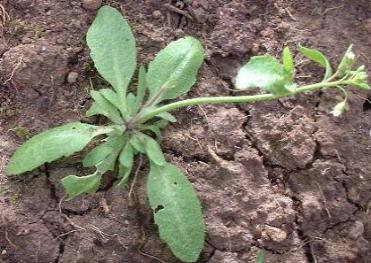Thale CressScientific Names: Arabidopsis thaliana syn.Arabis thaliana, Sisymbrium thalianum, Stenophragma thaliana |
This annual is a member of the Cruciferae Family and is ephemeral in that it can mature in as little as four weeks from germination, but usually in about six weeks. This short generational cycle makes Thale Cress ideal for genetic research and it has been the main plant used for work in Genetic Modification (GM) technology to develop herbicide-tolerant crops. It has only five chromosomes so the genome has been mapped and sequenced revealing about 25,000 genes so far. The bacterium Agrobacterium tumefaciens is used as a vector to transfer foreign DNA into the cells of the Thale Cress to create new genetically modified Cultivars. In the natural plant there are many variants and it can range from a tiny 1 to 2 cm, to over 20 cm in height, although the size can also be dependant on local conditions.
Germination occurs from February to December, it prefers well-drained bare soil on open ground, but also on walls and rocky places. The basal rosette of leaves are sometimes mostly gone by the time the flower stalk has matured - they are consumed by Slugs. As a cress, closely related to the mustards, the leaves are quite palatable, similar to Rocket, but milder - though it would take a while to assemble a meal from the thin pickings. The ones on the upright stem are a different shape.
The small, white, mainly self-pollinated flowers can appear all year round, but mainly from April to May and again from September to October. There can be a single upright flower stem or multiple stems. The long seed-pods grow almost at right-angles to the stem and contain about 30 seed each.
Because of its fine structure it is not considered as a serious arable weed as it does not compete with crops. It is untidy looking in the garden so should be eradicated if possible. It is easily uprooted by hand or by hoeing, remove the debris if flowers and seed-pods are present.
Weedkillers to use:-
A residual herbicide to prevent germination.
Paraquat, Diquat, contact action killing top growth, apply before flowering.
Glyphosate may not act quickly enough to prevent seeding.
Because of the similar flowers and long seed-pods it is sometimes mistaken for Hairy Bittercress, but the leaves are quite different. Another weed it could be mistaken for is Shepherd's Purse


A young plant